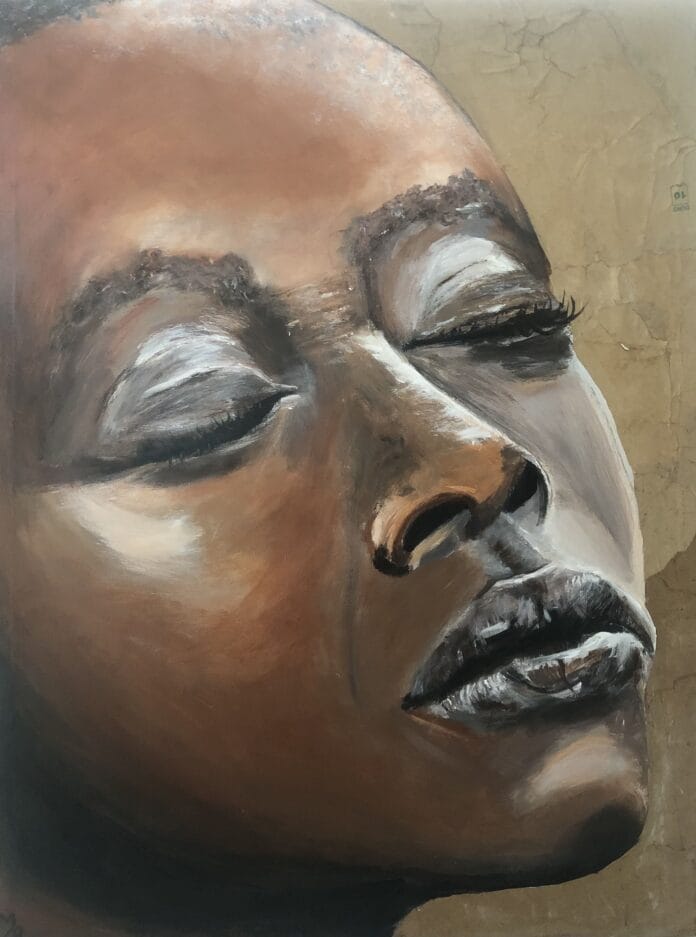Martina Petroll is a contemporary artist whose creative voice carries the essence of two very different landscapes: Germany, where she was born and raised, and Diani, a sun-soaked coastal town in Kenya, where she now lives and creates. Her work is a conversation between these worlds, shaped by emotional awareness, deep observation, and a profound connection to the natural environment around her. Over the years, Martina has developed an artistic language that is both raw and meditative, weaving together materials, memories, and moods into visual narratives that feel alive.
From Germany to Diani: The Evolution of an Artist
Growing up in Germany, Martina was surrounded by a culture that valued structure, tradition, and precision. Yet from an early age, she found herself drawn toward the sensory and emotional layers of life: colors, faces, shifting light, and the quiet stories hidden in human expressions. This intuitive sensitivity became the foundation of her artistic identity.
Her move to Diani marked a major turning point. The Kenyan coastline, with its bright skies, warm sand, lush greenery, and rhythm of daily life, opened a new chapter in her creative evolution. Here, Martina found not only inspiration but a deeper sense of self. Diani’s nature, people, and textures awakened her curiosity and encouraged her to explore beyond the traditional canvas. It is in this environment that she discovered her love for using unconventional materials and integrating the land itself into her work.
Emotional Artistry: Faces, Light, and the Unseen
Martina describes her art as an expression of her emotional journey. Every stroke, every layer, every chosen material reflects something internal, whether a feeling, a memory, or an attempt to capture a moment of stillness. Faces and figures often appear in her work, not as literal portraits but as vessels of emotion. She is drawn to eyes that hold untold stories, expressions that reveal vulnerability, and quiet gestures that speak louder than words.
Light plays an equally important role. In Kenya, the sunlight changes dramatically throughout the day, casting soft shadows in the morning and bold golden tones in the afternoon. Martina absorbs these transitions and channels them into her palette and textures. Her paintings are often illuminated from within, creating a sense of warmth, depth, and silent contemplation.
Materials that Speak: Driftwood, Paper, Rocks, and Soil-Based Pigments
One of the most distinctive aspects of Martina’s practice is her use of natural and repurposed materials. Instead of relying solely on traditional mediums, she searches for elements that carry their own life stories.
- Driftwood washed ashore becomes a symbol of journey and transformation
- Paper fragments and bags incorporate the marks of human use, time, and touch
- Small rocks add tactile honesty, grounding each composition
- Canvas remains her base, but it becomes only one part of a larger dialogue
Perhaps most striking is her use of pigments made from Kenyan soil. The rich earthy tones of Diani, deep browns, warm reds, and muted golds, offered her more than color. They offered connection. By grinding and refining soil into pigment, Martina quite literally fuses her environment into her work. Her paintings do not just depict the landscape; they contain it.
This intimate approach to materials reflects her belief that art should be alive, textured, evolving, organic, and honest.
About the Artwork: A Fragile Moment Captured
The artwork in focus, completed on 16 March 2025, measures 120 x 90 cm and stands as a powerful representation of Martina’s artistic philosophy. It is a mixed media piece dominated by acrylics, but its foundation begins with something less conventional: paper bags layered to form the background.
These paper layers create a raw, imperfect surface that mirrors the complexities of human emotion. On top of this textured base, Martina applies a loose brushstroke technique, allowing movement, spontaneity, and intuition to guide her hand. The looseness is intentional, designed to preserve a sense of openness and vulnerability within the composition.
The artwork embodies what Martina describes as a fragile moment, that fleeting space between tension and release, awareness and surrender. The softness of the brushwork contrasts with the roughness of the paper background, creating a visual balance between delicacy and strength. This contrast is central to her storytelling.
Meditative State: The Essence Behind the Work
At the heart of this piece lies a guiding theme:
Meditative state, cultivating an inner solitude, a calm and fearless state free from expectations and attachments.
This sentiment encapsulates not only the meaning of the painting but also Martina’s personal journey. For her, the meditative state is not about escape. It is about presence, meeting oneself with clarity, gentleness, and courage. It is the ability to stand quietly with one’s emotions without forcing them into shapes or definitions.
Through texture, color, and material, the artwork becomes a visual meditation. Viewers are invited to pause, breathe, and find a moment of calm within the layers. The earthy pigments and organic elements root the piece in the physical world, while the flowing brushstrokes guide the viewer inward toward reflection and inner quiet.
Conclusion: Art That Lives, Breathes, and Belongs
Martina Petroll’s work is more than mixed media; it is a lived experience captured on canvas. It combines the discipline of her German upbringing with the freedom and vibrancy of her Kenyan environment. It blends found materials with emotional depth, and it transforms everyday elements into profound artistic expressions.
Her art reminds us that beauty exists in the imperfect, the natural, and the deeply personal. Each piece invites the viewer into a world where fragility becomes strength and where stillness becomes a powerful form of presence.
In Martina’s hands, soil becomes color, paper becomes memory, and a moment of inner solitude becomes timeless art.


